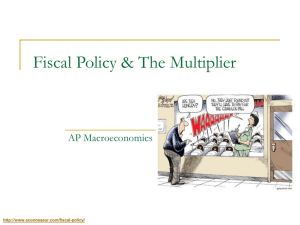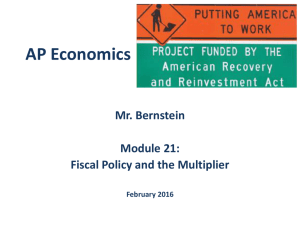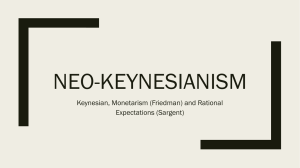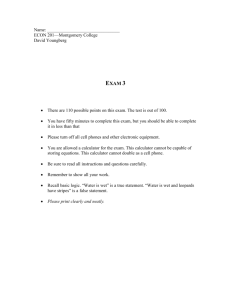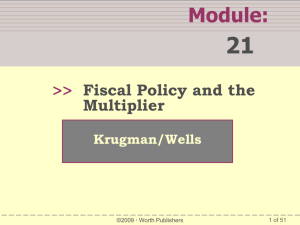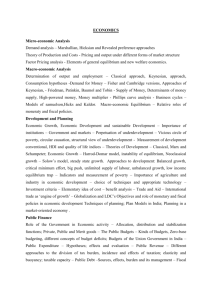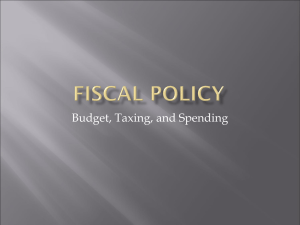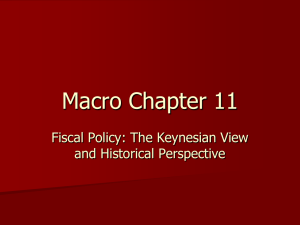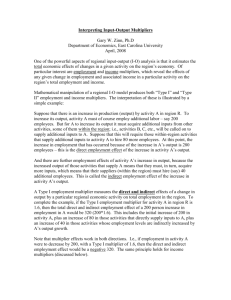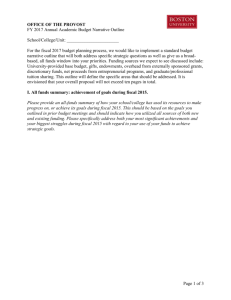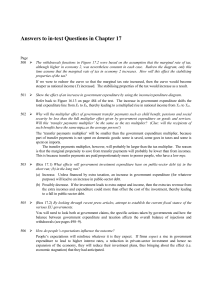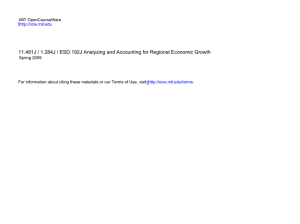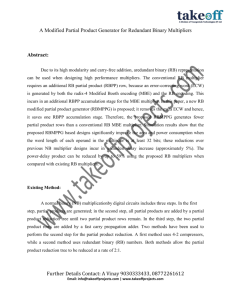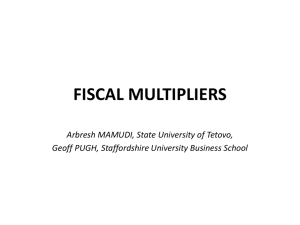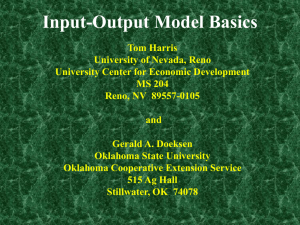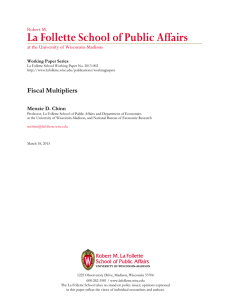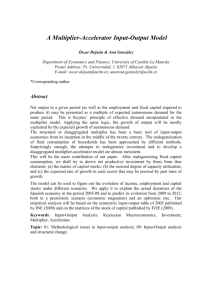Dave Swenson - Department of Economics
advertisement
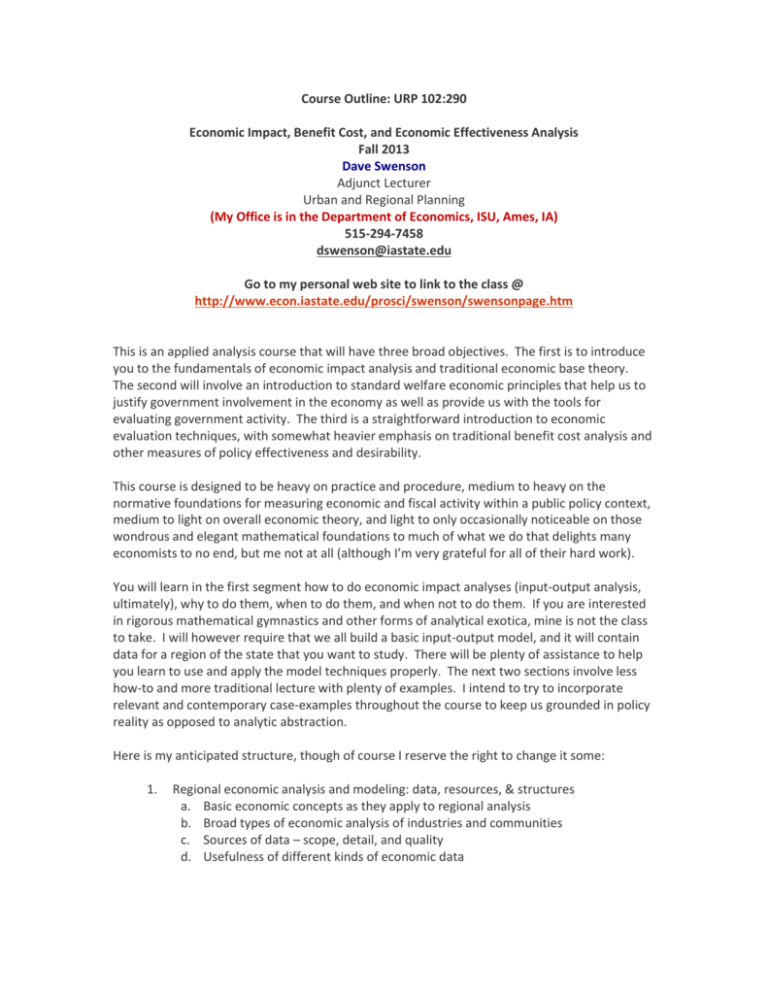
Course Outline: URP 102:290 Economic Impact, Benefit Cost, and Economic Effectiveness Analysis Fall 2013 Dave Swenson Adjunct Lecturer Urban and Regional Planning (My Office is in the Department of Economics, ISU, Ames, IA) 515-294-7458 dswenson@iastate.edu Go to my personal web site to link to the class @ http://www.econ.iastate.edu/prosci/swenson/swensonpage.htm This is an applied analysis course that will have three broad objectives. The first is to introduce you to the fundamentals of economic impact analysis and traditional economic base theory. The second will involve an introduction to standard welfare economic principles that help us to justify government involvement in the economy as well as provide us with the tools for evaluating government activity. The third is a straightforward introduction to economic evaluation techniques, with somewhat heavier emphasis on traditional benefit cost analysis and other measures of policy effectiveness and desirability. This course is designed to be heavy on practice and procedure, medium to heavy on the normative foundations for measuring economic and fiscal activity within a public policy context, medium to light on overall economic theory, and light to only occasionally noticeable on those wondrous and elegant mathematical foundations to much of what we do that delights many economists to no end, but me not at all (although I’m very grateful for all of their hard work). You will learn in the first segment how to do economic impact analyses (input-output analysis, ultimately), why to do them, when to do them, and when not to do them. If you are interested in rigorous mathematical gymnastics and other forms of analytical exotica, mine is not the class to take. I will however require that we all build a basic input-output model, and it will contain data for a region of the state that you want to study. There will be plenty of assistance to help you learn to use and apply the model techniques properly. The next two sections involve less how-to and more traditional lecture with plenty of examples. I intend to try to incorporate relevant and contemporary case-examples throughout the course to keep us grounded in policy reality as opposed to analytic abstraction. Here is my anticipated structure, though of course I reserve the right to change it some: 1. Regional economic analysis and modeling: data, resources, & structures a. Basic economic concepts as they apply to regional analysis b. Broad types of economic analysis of industries and communities c. Sources of data – scope, detail, and quality d. Usefulness of different kinds of economic data 2. Economic base theory a. In the beginning b. Then there was Keynes c. Total multipliers; multipliers considering marginal change d. Pros and cons of economic base assumptions e. Economic base simplified f. Assignment 1: applying the elements of economic base analysis 3. The structure of regional industrial accounts – The beginnings of input-output modeling a. Industries, commodities, and institutions b. Social accounts matrices c. Simple I X I transactions 4. The practice of economic impact assessment a. What it is, what it isn’t b. The terms, their meanings, and their limits c. Understanding inter-industrial linkages d. Discerning impacts, causality, etc e. Looking at the big picture f. Distinguishing between a good one and a bad one – some cases 5. Introduce students to an actual, home-built, spreadsheet-based, (and highlyhyphenated), input-output model. a. This is a practical bridge between the matrix math that is usually taught in these courses and interpreting a set of current I x I accounts. b. Learning to use the Use and the Make tables for actual analysis and community economic assessment. c. Step-by-step impact assessment through the spreadsheet d. Discussion of the results and the limitations of the analysis e. Assignment 2: Students will take a SAM that I provide and replicate the steps. 6. Using Dave’s Pretty Good Impact model – LAB and technical assistance a. Actually using a spreadsheet-based IO model b. Work directly with students in scenario development, problem solving, and modification of their impact scenario. c. Provide advice and assistance (on-site and long-distance). Scenarios critiqued and approved. d. Assignment 3: Students will use DPGI model to evaluate two economic change situations that I will specify. 7. Using Multiplier Tables to do Impact Analysis – Brief introduction to fiscal impact analysis. a. Learning about final demand multiplier tables. b. Applying the tables to two basic change scenarios 8. Using an area-specific set of multiplier tables to evaluate your own impact scenario(s). a. Getting started b. Each student will specify an actual or hypothetical economic change situation that I will critique and approve. c. I will share a few economic impact analyses for students to review and comment on. d. Assignment 4: Students will prepare an economic assessment of their approved scenario. The report will not be longer than 6 pages, including all supporting tables. 9. Joining modeling and evaluation: a. Fiscal impact assessment b. Conjoined modeling: Fiscal, labor, and economic impacts – considering the dynamics and imperatives of space c. Assignment 5: students will use multiplier tables to calculate impacts; compile a simplified fiscal impact summary. 10. An introduction to Government’s roles in the economy a. Public project evaluation basics b. The concepts of welfare economics c. Market failures and government roles 11. Introduction to benefit cost analysis a. The time value of resources b. Finalizing our benefit cost structure 12. Cost effectiveness analysis a. Non-monetary evaluation methods b. Last assignment on BCA and cost effectiveness 13. Understanding contemporary evaluation issues a. Limits to economic analysis of public projects Evaluation and Grading Summary Assignment 1 Economic base analysis Assignment 2 I-O / SAM analysis Assignment 3 Using the DPGI model Assignment 4 Students Scenarios / Multiplier Analysis Assignment 5 Fiscal impact evaluation Assignment 6 Last Assignment on BC and Evaluation Final Paper or take-home essay pertaining to last two sections General class participation and attendance 10% 10% 10% 15% 15% 10% 25% 5% Grading is done strictly on the attached scale: Resources: I intend to rely heavily on electronic or web-based sources for this class, plus supplemental readings from my own resources. I should be able to hustle up ample public domain resources to under-gird this class and to lighten up your text book load. Initial reading information: Parts 1-3: Schaffer, William. Regional Impact Models. 1999 Regional Research Institute, WVU (and in the web-book for regional sciences); and Otto & Johnson’s, Micro-computer Based Input Output Modeling (other selected readings will be distributed in class) Parts 4 – 8: I will rely on resources, data, and techniques that I provide. Part 9: I will assign a set of selected articles or basic readings pertinent to the section, again, that I will provide or provide access to. For Parts 10 through 12 I am going to use an older book by Edward M. Gramlich as the basis for my lectures. I will make a version of this book available to you to consult, just like a reserve version, and if any of you are interested in a very readable book on this topic, I recommend that you buy a used one. It is more formally: Edward M. Gramlich. Benefit-Cost Analysis of Government Programs. Prentice-Hall, Inc., Englewood Cliffs, NJ. 1981. All other readings or resources I will post electronically as needed. For Those in Need of Disability-Related Services or Accommodations. This is the University’s Statement: The University of Iowa welcomes students from diverse backgrounds, including students with disabilities. In accordance with University policies and state and federal law, every faculty member has an obligation to support the success of students with disabilities. Per Section 504 of the Rehabilitation Act, faculty members are specifically required to provide reasonable academic accommodations for students with documented disabilities. Policies and information concerning this obligation are on the web. Students with special needs or looking to access information on their rights or University policies should contact Student Disability Services.
